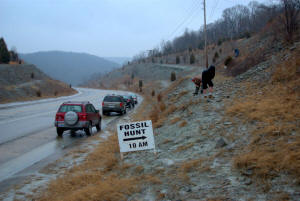
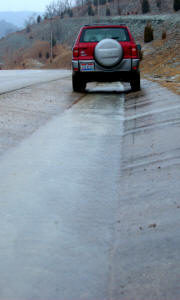
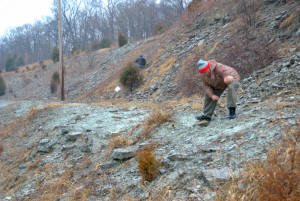
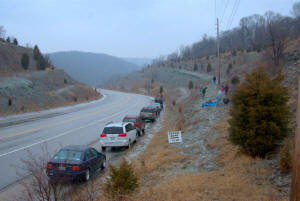

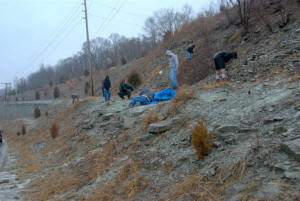


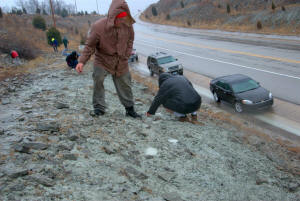

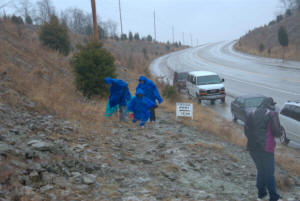
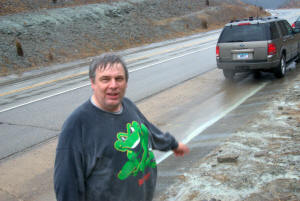
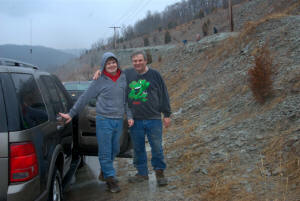
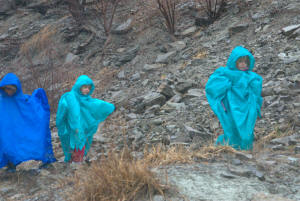
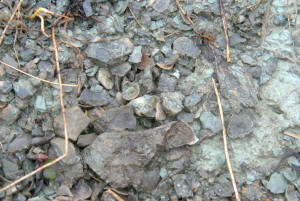
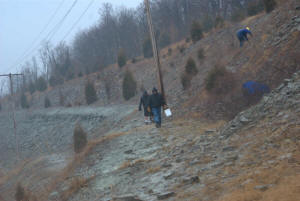
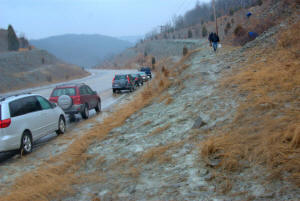
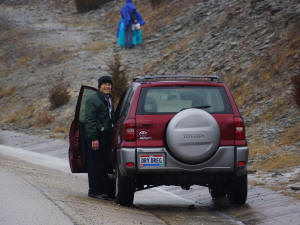
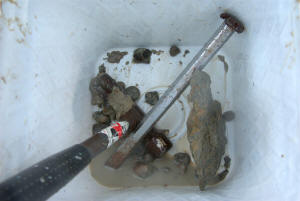
Photos by Bill Heimbrock and Cindy Striley
Descriptions and
fossil identifications by Bill Heimbrock
Fossils Found That Rainy Day
Trilobites
Quite a few complete Flexicalymene retrorsa minuens trilobites were found despite the rain. You wanted to avoid stepping in the soft, clay "butter shale" or you would sink and prevent the trilobites from being discovered. The trilobites were in the process of being washed out of the shale. You could see this process standing there observing the clay being pounded by rain. It is important to rescue Flexicalymene trilobites from the rain because they break apart fairly quickly after being exposed to the surface.
In this first picture, you can see this weathering process in action. There is a
whole enrolled trilobite coming to the surface and about to be washed down the
slope. It was more fortunate than most and was rescued by a Dry Dredger.

Here's the happy trilobite rescued and ready for a good cleaning.
Here are a few more Flexicalymene trilobites rescued that day.
Fragments of the trilobite Isotelus sp. were also
found littering the shale. They were too difficult to rescue.
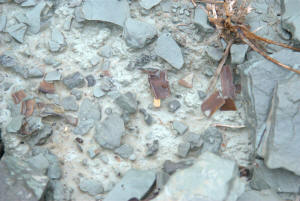
Brachiopods
Brachiopods were everywhere. In the Richmondian Stage of the Cincinnatian Series formations exposed at this site, you can find in a single outing more than a dozen varieties of brachiopod. This is one reason why we have fossil collections in our region.
The brachiopod Strphomena sp. (pictured below)
occurs in large numbers when they are found in specific layers. They are a
lighter shade of brown than other brachiopods and are easy to see when it rains.
The photo below shows a bunch of Strophomena sp.
cemented together by shale. Continued exposure to water will eventually separate
this group as the shale softens and becomes clay.
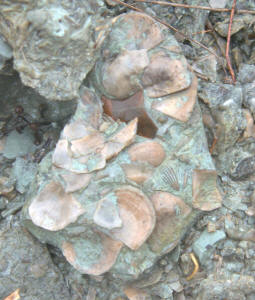
Some Strophomena sp. were found free from the matrix.
Pictured below is one specimen showing both valves (shells).
An even more common brachiopod found was
Lepidocyclus perlamellosum. (Next 2 pics complements of Cindy
Striley)
The photo below, complements of Cindy, shows a typical mix of fossils found on
this site. Pictured are Strophomena sp, Hiscobeccus
capax, Lepidocyclus perlamellosum, Glyptorthis
insculpta and Plaesiomys subquadratus.
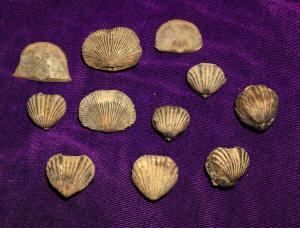
Here's what a group of those brachiopods looks like on the surface of a slab -
all broken and messed up.
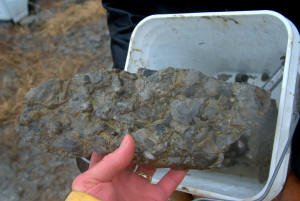
Coral
The most common coral found was this rugose solitary coral (Horn Coral) named
Grewingkia sp.
On the surface of some of these Grewingkia is scribed borrows and scratch marks that may leave you guessing what made them. Fortunately, the specimen pictured below (next 3 pics) has the "smoking gun." It appears to have remnants of bryozoans in the grooves.
Another common horn coral we found was Streptelasma sp. This coral is smaller
than Grewingkia and has more of a widening "trumpet" shape. You can also
sometimes see a flatted tip where the coral attached to an object on the sea
bottom.
Ichnofossils (Trace Fossils)
There was a wide variety of trace fossils on this site. This first example
appears to have segments. I'm not sure what made this, but we are looking at an
in-fill.
A variety of burrow in-fills were found. Some had lines on the surface that might have been made by legs. (next 2 pics)
This next one is strange. Perhaps it's the body replacement or in-fill of a
sponge. I welcome comments and speculation on its identity. Email
billheim@cinci.rr.com.
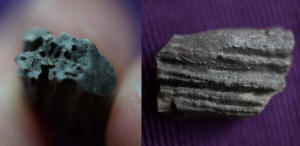
Here are a few pics of some of the other trace fossils found. (3 pics
below).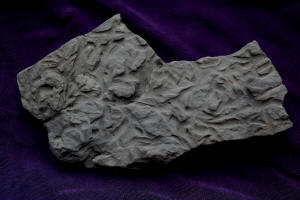
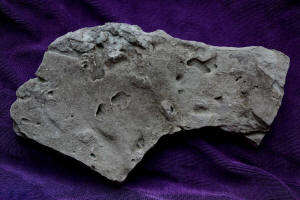

A CAUTIONARY TALE
I will admit, I was fooled by this apparent fossil at first. As you can see from the first four photos below, it looks a lot like an Ordovician sponge called Beatricia.
However, when I got it home and washed it, the true identify was quickly revealed.
It had pores.
AND WHEN I WASHED IT, IT FLOATED! Remember - real fossils are made of rock and
even when porous, they will most often sink in water.
And yep, when wet, it was a bit squishy. Not the quality of a 440 million year-old fossil.
The true identity: A PARTIALLY PETRIFIED CIGARETTE FILTER FROM THE 20th CENTURY!!!
Yes, I was embarrassed. But at least I figured out what it was before I showed it around proudly.
That's all for this fossil trip. We would have found more if it wasn't raining the whole time. Hope you enjoyed it with us.
See previous field trips to this Southeast Indiana fossil Mecca.
April 2013
April 2012
May 2011
March 2010
September 2008
September 2007
September 2006
March 2006
March 2004
October 2003
April 2002
Now let's see our DRY April 2014 field trip to a scenic byway in Northern Kentucky.
Back to the Field Trip Index Page
Return to Dry Dredgers Home Page
The Dry Dredgers and individual contributors reserve the
rights to all information, images, and content presented here. Permission to
reproduce in any fashion, must be requested in writing to admin@drydredgers.org.
www.drydredgers.org is designed and maintained by Bill Heimbrock.